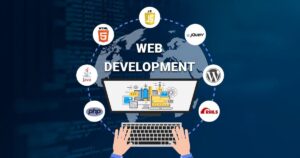
In the fast-evolving world of web development, three roles often come up—front-end, back-end, and full-stack. Understanding the difference between these roles is essential for anyone starting a career in tech or looking to hire the right developer for a project. In this article, we’ll explore what each role entails, the tools they use, job trends, and real-world project examples.
What Is Front-End Development?
Front-end development focuses on the visual and interactive parts of a website or application—the part users see and interact with directly. Front-end developers are responsible for building the layout, design, and user experience (UX).
Common Front-End Tools & Technologies
- Languages: HTML, CSS, JavaScript
- Frameworks/Libraries: React, Angular, Vue.js
- Styling: Tailwind CSS, Bootstrap, Sass
- Build Tools: Webpack, Vite, Babel
- Version Control: Git + GitHub
Example Project
Creating a responsive portfolio website using React and Tailwind CSS, with animated transitions and a contact form.
What Is Back-End Development?
Back-end development deals with the server-side logic and infrastructure that power websites and applications. These developers create and manage databases, servers, APIs, and authentication systems.
Common Back-End Tools & Technologies
- Languages: Node.js, Python, PHP, Ruby, Java
- Frameworks: Express.js (Node), Django (Python), Laravel (PHP)
- Databases: MongoDB, PostgreSQL, MySQL
- APIs: RESTful APIs, GraphQL
- DevOps Tools: Docker, AWS, Nginx
Example Project
Building a REST API with Node.js and Express to serve data for an e-commerce site, connected to a MongoDB database.
What Is Full-Stack Development?
Full-stack development refers to the combination of both front-end and back-end work. Full-stack developers are proficient in building entire applications from scratch and are versatile team members in both startups and large enterprises.
Common Full-Stack Stacks
- MERN: MongoDB, Express, React, Node.js
- MEVN: MongoDB, Express, Vue.js, Node.js
- LAMP: Linux, Apache, MySQL, PHP
- JAMstack: JavaScript, APIs, and Markup (with static site generators like Next.js)
Example Project
Developing a full-fledged blog platform with user login, admin panel, content editor, and SEO-friendly pages using the MERN stack.
Career Trends and Job Outlook
Web development roles are in high demand worldwide, and employers often seek developers who can adapt across multiple layers of the tech stack.
Job Market Snapshot
| Role | Avg. Salary (US) | In-Demand Skills |
|---|---|---|
| Front-End Dev | $75,000 – $110,000 | React, JavaScript, CSS |
| Back-End Dev | $80,000 – $120,000 | Node.js, Python, SQL |
| Full-Stack Dev | $90,000 – $130,000 | React + Node.js, APIs |
Source: Glassdoor, 2024
Which Path Should You Choose?
- Choose Front-End if you love design, UX, and visual storytelling.
- Choose Back-End if you enjoy logic, data structures, and working with servers.
- Choose Full-Stack if you want flexibility and control over entire applications.
For beginners, starting with front-end development is often the most accessible way to enter the field before expanding into back-end and full-stack roles.
Final Thoughts
Understanding the differences between front-end, back-end, and full-stack development can help you choose the right learning path or hire the right talent. Whether you’re building personal projects or working in a professional environment, each role plays a critical part in delivering powerful and engaging web experiences.



